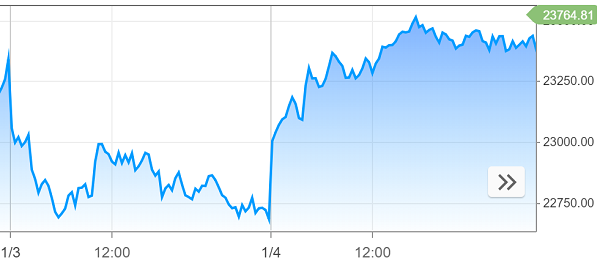The American Social Science Associations (ASSA) 2019 annual meetings took place over three days this past weekend in Atlanta. The annual meetings always include more than ten thousand PhD economists, finance scholars, and journalists gathered in the ultimate Nerdfest, as one financial journalist dubbed it.
Most of the world paid attention only when Federal Reserve Chair Jay Powell announced in a speech on Friday morning that the Fed will exercise discretion in rate hikes after a difficult December. Stock markets rebounded ending the day up 3.3% on January 4.

Source: CNBC.com (symbol .DJI)
But the actual import of the meetings is the new research presented in the smaller, more focused, panels. Additionally, this year, discussions turned inward as several sessions focused on gender issues in the profession. I review some of the more interesting panels I attended.
Blockchain
Luigi Zingales of the University of Chicago chaired a panel on the myth and reality of blockchain. Eric Budish of the University of Chicago presented that decentralized trust—a key component of blockchain—is expensive at scale, and more traditional, non-blockchain, mechanisms of trust like the rule of law and governance may be cheaper. Adair Morse of the University of California-Berkeley critiqued the energy costs associated with crypto mining, noting that 70-83% of cryptocurrency mining occurs in China in areas that generate electricity from coal and nonrenewable energy sources. She said energy used to mine tokens crowded out more socially beneficial uses of energy. David Yermack of New York University defended the promise of public and private blockchains. To some skepticism from other panelists, he called blockchain the “most interesting financial innovation since double-entry bookkeeping in the 14th century.”
Gender in the Profession
Betsey Stevenson of the University of Michigan chaired a panel on gender in the economics profession. She noted that the male-dominated culture of economics has generally not changed with the times, driving young women away from the field and towards other professional disciplines, such as medicine or computer science, that have at least made bigger efforts to be more inclusive. Susan Athey of Stanford University emphasized the difference between computer science and economics departments. Brilliant computer scientists ask questions in seminars in a respectful manner, she said, while economists in top departments often interrupt and rudely interrogate speakers. She also noted that universities and top journals tend to protect star economists who are known to behave badly. Marianne Bertrand of the University of Chicago said that much of this culture stems from male economists who received aggressive treatment from their own advisers and continue the tradition. But, she notes, “toughening up” young economists via hostile behavior is unnecessary and is a tradition that should have been abandoned long ago.
The lack of women, moreover, begets a continued lack of women. For example, Janet Yellen, former chair of the Federal Reserve and currently of the Brookings Institution and, notably for this panel, the first female assistant professor of economics at Harvard University, recognizes now that her scholarly collaborations with the second female professor in the department were probably due to their gender, rather than subject matter expertise. Sebnem Kalemli-Özcan of the University of Maryland emphasized that addressing the issues driving women away from the profession should be well within the profession’s ability to fix, especially for scholars who find solutions to daunting world problems.
Economic Research in Tech Firms
Carolyn Evans of Intel moderated a panel to discuss economic research in tech firms. Jonathan Hall of Uber discussed the role of the approximately 30 economists in his company. He noted the many ways tech firms employ PhD economists, ranging from public relations to business strategy. Economists can add value, he said, by explaining incentive models to non-economists and in general communicating economics to decision makers. But in order to make those contributions they need to learn how to better communicate in a business environment. Hall noted that he coaches economists to, for example, avoid any word that ends with “’dogenous,” say “incremental” instead of “marginal,” and not complain about something without offering an implementable solution.
Ramon Huerta of the University of California-San Diego presented research in which he used deep learning and neural nets to analyze Amazon product data to develop new inflation indices. Steven Tadelis of the University of California-Berkeley described how artificial intelligence and machine learning can influence market design, with examples from eBay, Taobao, and spectrum auctions. Imke Reimers of Northeastern University presented work measuring the effects of self-publishing on traditional institutions and how self-publishing can impact licensing payments. She finds evidence that in certain cases self-publishing provides efficiencies to writers and traditional publishers. Output of good ideas has increased, license payments to authors have increased by 15%, and prediction error by traditional publishers to find best sellers has decreased by 20%.
New Data Generated by Tech Firms
Michael Bailey of Facebook chaired a panel on new datasets for finance and economics research. He noted his company’s work to create datasets such as the Social Connectedness Index. Facebook provides access to these datasets to scholars who send abstracts of their research questions. Rebecca Diamond of Stanford’s Graduate School of Business noted that new datasets hold promise to answer research questions in household finance that traditional datasets cannot answer. Transaction data, such as that potentially available from Amazon or eBay, offers far more granular insights into household decisions than Census data can offer. She presented a study based on Uber data that explained a gender wage gap with experience effects. Her study showed that male drivers tend to drive more hours than female drivers, suggesting that they earn higher wages per hour from experience, perhaps by learning to schedule more profitable routes.
The panel also discussed some of the pitfalls of new data. Scott Ross Baker of Northwestern University described his work to create an Economic Uncertainty Index and his research with proprietary data from Mint.com. He cautioned young scholars of the risks of investing years of research in datasets that may not have persistence or stability over time. Proprietary data may not be available to other researchers for peer review and may be more poorly documented without data dictionaries.
Camelia Kuhnen of the University of North Carolina discussed the benefits and costs of submitting new data to journals with editors and referees who are unfamiliar with new methods and big data infrastructure. She emphasized repeatedly that new data may be fascinating, but that scholars need to first ask a research question, and the data should answer the question. Otherwise she analogized, new data is just a big hammer wielded against small nails.
Ten Years After the Financial Crisis
Ben Bernanke of the Brookings Institution, Timothy Geitner of Warburg Pincus, and Henry Paulson of the Paulson Institute shared with Greg Ip of the Wall Street Journal their reflections on the financial crisis ten years ago. They discussed the policy levers they had available and created, including quantitative easing, the Troubled Asset Relief Program, conservatorship of Fannie Mae and Freddie Mac, and fiscal stimulus in the Recovery Act as implemented by the Federal Reserve, Treasury Department, and Congress. Elegant solutions are elusive in times of crisis, they said, as each soberly recounted the chronology of events in 2008 and 2009.
Paulson explained why Bear Stearns was saved and not Lehman: In March 2008, JP Morgan was willing to buy Bear Stearns, but no banks were willing to buy Lehman leading to its failure in September 2008, despite dozens of calls between Paulson and Lehman CEO Dick Fuld that summer. Geitner reviewed the contentious issue of why homeowners were not bailed out while lenders were: emergency funds were necessary for restoring financial stability in bank and non-bank institutions, not for compensating individual losses from foreclosure. In the future, Geitner recommended, officials should err on more, rather than less, intervention to contain a crisis due to the secondary and tertiary effects of financial instability on the economy. Paulson offered a thumbs-up to this advice with a hearty nod of agreement.
Public Debt and Low Interest Rates
Olivier Blanchard of the Peterson Institute for International Economics, and formerly chief economist of the International Monetary Fund, presented a new paper in a lecture as outgoing president of the American Economics Association. In his new paper, he shows that public debt is not good, but might not be all that bad. Public debt may not be as costly as it appears if the safe rate is below the growth rate, where the safe rate is the risk-adjusted rate of return on capital and the growth rate is the rate of growth in nominal GDP. Blanchard simulated a range of interest rates with variations on his model under rate certainty and uncertainty. He showed that historically the average safe rate has been below the growth rate since 1950, except for a decade in the 1980s. While today’s rate environment in the United States, United Kingdom, and Europe appears to raise concerns about public debt and growth, Blanchard noted that interest rates are not particularly unusual today.
John Bates Clark Medal
Parag Pathak of the Massachusetts Institute of Technology was awarded the Bates Clark medal for outstanding research under the age of forty. Pathak has advanced the understanding of market design with models to shape a school choice plan implemented by Boston Public Schools and student assignments in New York City. He thanked his wife and young sons for their support as well as his father and mother, with a round of applause from the room, describing their story immigrating from Nepal.
CNN Center
Atlanta is more than just Delta, Coca-Cola, and the Braves. It’s also the headquarters of President Trump’s favorite network—CNN. During a break, I toured the studios at the CNN Center, the home-base of several programs including Headline News, Morning Express with Robin Meade, and CNN en Español. At $300,000 apiece, the robotic studio cameras are controlled remotely by technicians. This original location of Turner Broadcasting Systems still manages CNN web news and international content, and during election season hosts over 250 people generating CNN web content.
And that’s all until next year’s ASSA meetings. To paraphrase the conclusion of the Passover Seder, L’Shanah Haba’ah b’San Diego!


